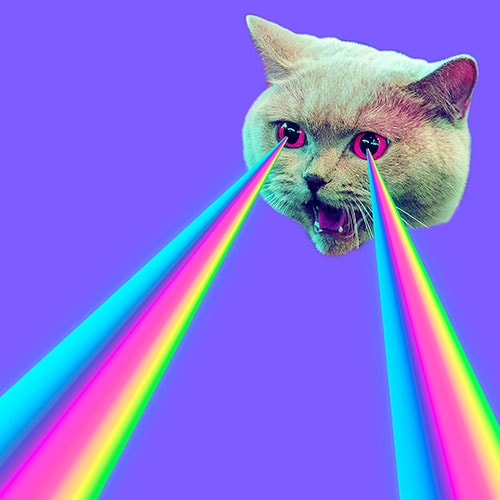T&G’s top five branding trends (for good) in 2023
December 15, 2022
Trends are an interesting thing, right? They either pass us by completely or we lean so far into them that people think we’ve joined a cult. More than fleeting fads, meaningful trends keep us in touch with the Zeitgeist and give us direction in an ever-changing world. Trends are extremely powerful in the branding space because they offer new and unique ways to express ourselves. The most successful executions of a trend will intrigue and inspire, and make people connect with the brand on a deeper level – or maybe even for the first time. Getting behind a trend deepens our sense of belonging to something and strengthens our alignment with it. In the branding world, that’s called loyalty.
We try to keep our eye on the pulse and our finger on the radar (that’s Darren-speak) and our prediction for 2023 is that the strongest brands will be aligned with the overarching trend of business for good. More and more of our clients are getting on board, and some of the world’s biggest brands are making huge commitments to business with purpose, or business for good too.
“As the race towards achieving the UN’s Sustainable Development Goals (SDGs) gathers pace with some milestones pegged to 2030, for-profit brands that want to genuinely do good – socially and environmentally – must do more than have a token charity partnership here, or some carbon offsets there. Business for good needs to be baked into their business and brand strategy – that they do these things because it’s who they are, rather than just what they do. Green and social washing is becoming more commonplace and less tolerated by the market, simultaneously. Those brands who embrace ESG (Environmental, Social and Governance) with pure intent and who execute well, will stand out over those who don’t.”
Darren Taylor, MD & Head of Strategy and Research
‘Business for good needs to be baked into their business and brand strategy - that they do these things because it’s who they are, rather than just what they do.’
1. Leading with social purpose
It’s probably no surprise to anyone that government leaders and journalists are seen as the least trusted leaders in society. We’ve lost faith in their competency, ethics, and ability to do the right thing. Once pillars of society, they’re now crumbling and fuelling a cycle of distrust in our world. So we the people are now looking to businesses – yes, companies – to step up and lead from the front.
According to the 2022 Edelman Trust Barometer, societal leadership is now a core business function, meaning brands must take a stand on societal issues like climate change, economic inequality, workforce reskilling and trustworthy information. “More than a trend, it’s become a necessity for businesses to put on their big boy pants and lead from the front”, says our Strategist, Millie. But why should businesses care? Well, stakeholders are holding them to account. When 58% of stakeholders will buy or advocate for brands based on their beliefs and values, 60% choose a place to work based on their beliefs and values and 80% will invest based on their beliefs and values, you’d be silly not to reflect on your own beliefs and values.
Daniel is Head of New Markets at T&G. “Execution and accountability are going to be key more than ever”, he says. “Companies will not only have to define their social purpose and build a strategy around it but will have to make sure they have timely execution and they’re accountable for their results. Otherwise, it’s going to be like empty election promises – even more detrimental than not doing anything at all”. To win with your stakeholders – all of them – you need to build social purpose into your brand strategy. “Brands need a true, genuine and honest social purpose. Maybe I’m a bit biassed, but business can’t just be about making money (although that’s great)”, says Millie. “It’s about doing good shit and moving the needle forward. Businesses have the opportunity to be the heroes here.”
Ask yourself, “what does my business do for society?”. If you need help, you can always ask us.
‘Brands need a true, genuine and honest social purpose. Maybe I’m a bit biassed, but business can’t just be about making money (although that’s great)”, says Millie. “It’s about doing good shit and moving the needle forward. Businesses have the opportunity to be the heroes here.’

2. Supply chains for good
Social enterprises are businesses like any other, but they exist specifically to make the world a better place. That could be creating jobs for the most marginalised, providing much-needed community services or protecting the environment – while still making a profit to keep staff paid and the business growing. One of the most successful Australian social enterprises is Who Gives a Crap, a toilet paper company that gives half its profits to building toilets in the developing world. With a 200% growth in businesses supporting social enterprises and a 75% growth in social enterprises being established (2018-2020 FY), the trend towards switching procurement to social enterprises is undeniable.
“In terms of brand, choosing social enterprises as suppliers (social procurement) means that goodness is intrinsically knitted into your business rather than the charity add-ons of the past.” Our Head of Content Aoibheann has worked closely with many of our social enterprise clients and partners. “Building these meaningful partnerships is fairer, more sustainable and great for job creation on both sides. It’s easy to make the switch. The organisations that are choosing to act in line with their brand values are the ones attracting the top, fresh talent too.”
What’s not to like? You can switch to more ethical suppliers or practices through Social Traders in Australia.
‘The organisations that are choosing to act in line with their brand values are the ones attracting the top, fresh talent too.’
3. Design with heart
Simon is our Senior Brand Creative & Digital Specialist and has seen a lot of trends come and go. “It’s very hard to pin down a ‘trend’ that’s consistent across all industries. There’s been a lot of discussion around the whole ‘anti’ movement recently, but is it something that’s going to continue for long?”, asks Simon. “There’s still plenty of design out there that goes against this aesthetic – but that’s what’s so good about design – it’s in a constant state of flux.” The past few years have seen an explosion in distorted typography, candy pastels and vibrant minimalism – as brands incorporate this ‘independent’ style into their brand DNA, their ability to stand out from the crowd is diminished. In order to be seen as authentic and unpretentious, more and more brands are embracing ‘anti-branding’ – think monochromatic packaging, minimal branding, and stripped-back messaging. While this can be presented in a refined manner, it can lack warmth, so another dimension to this is the use of handwritten and ‘imperfect’ type applications to give their brand a human dimension.”
KerryAnn, is T&G’s Senior Designer “Brands don’t want to be seen to be spending all their money on promotion and ‘show’. Stripping back design can be telling – it tells of a focus on a simpler approach and more meaningful priorities for the brand”. The brand will come across as more authentic when the layer of embellishment or a sense of indulgence is taken away. Melio Skincare is an excellent example of a brand applying its ethos to every product they sell, by choosing packaging that uses recycled materials and eco-friendly inks.
‘Stripping back design can be telling - it tells of a focus on a simpler approach and more meaningful priorities for the brand.’
4. Authentic communication
The era of saying what you mean and meaning what you say is well and truly here. In post-COVID research, it’s been found that 88% of consumers say authenticity is a key factor when deciding what brands they like and want to support. “If you’re not sure where to start, a good basis for authentic communication is to have clarity on your brand’s values, vision and CSR strategy”, says Aoibheann, our Head of Content. “Once you’re clear on where your company is heading, this will make starting or engaging in relevant conversations a lot easier”.
Some brands that nail authentic communication are Alchemy Construct, Who Gives a Crap and Patagonia. If you look closely, you can see they’re engaging in conversations that align with their vision, mission and values as brands that do good in the world. Whether it’s making the case for employing more female staff in a male-dominated industry or commissioning a study into deforestation because they couldn’t find the information on it themselves – these brands are doing good things – and it gives them positive things to talk about.
Communication that’s honest and authentic is definitely not new and it’s much easier than you think. “Authenticity will be tricky for some, but it will be well worth the soul searching, says T&G’s Senior Copywriter Melinda. “Authentic communication needs you to look inside your brand, and maybe deep inside yourself too. Read some of your copy out loud and ask yourself if it sounds human enough. Turn your communications with your audience into conversations and share the human side of your brand wherever possible. It’s ok to be vulnerable – in fact, it’s key!”

‘If you’re not sure where to start, a good basis for authentic communication is to have clarity on your brand’s values, vision and CSR strategy.’
5. Stop! Collaborate and listen.
Being able to play nice with others is dramatically undervalued. “Post-covid, it’s become more important than ever to make space to collaborate with your teams – even if it’s virtual.” Says Millie. “Collaboration is a team effort that creates space for fresh and diverse opinions”, says T&G Account Manager Georgie. “For us, it means clients are as actively involved in good outcomes for their brand as we are. This is what brand guardianship is all about. Making clients a part of the process makes it much more engaging for them and for us. It also produces results that are much richer and longer lasting.” It also levels the playing field where everyone from the interns to the Board of Directors has the chance to share their own unique perspective. T&G’s Content Intern Aiman believes cross-generational insights are vital (we all do tbh). “Having an authentic, human brand truly matters, and with Gen Z favouring authenticity over all, it’s vital that brands remain honest, transparent and even vulnerable. I mean there’s a reason we have seen such a tremendous rise in digital and social media (especially TikTok!), which is more personal and intimate, and favoured by younger generations”. Strategy intern Gabi agrees “Collaboration truly is key, especially today where trends come and go in the blink of an eye. So having those different perspectives on board ensures we’re not left behind on shore while others are riding the wave. Collaboration also means we’re always learning from each other”.
‘Brand strategy, design, communication, and execution is nothing if everybody thinks you're an arsehole”, says our GM Craig Bulman.’
The reputation you build is deeply embedded in the interactions others have with you and the people who represent your brand. “Brand strategy, design, communication, and execution is nothing if everybody thinks you’re an arsehole”, says our GM Craig Bulman. “It’s important to be tough in business when it’s needed but if you can be authentic and be a decent person most of the time, people will want to deal with you and work with you”. There’s also undeniable power in taking a collaborative approach to everything you do.
If you’d like to learn more about fueling your vision and becoming a true leader in the marketplace, download our ebook.
